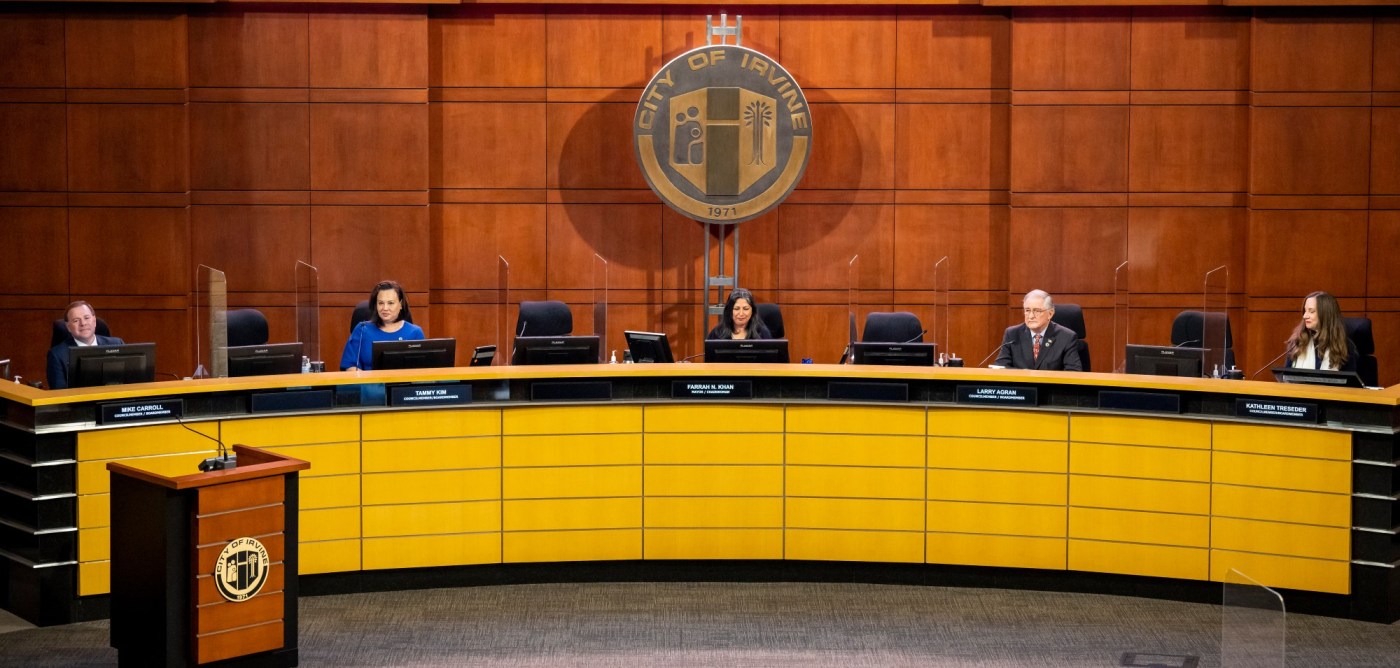Irvine leaders are seeking community input as the city moves toward hosting by-district elections.
After previous councils resisted pressure — and the threat of a lawsuit — to make the switch to by-district elections, where voters would choose only the one council member who lives within their geographic area, councilmembers in January decided to look at it further.
If the new voting system is approved by Irvine voters in March 2024, the size of the City Council would increase from five to seven members, with only the mayor elected at large.
The new system would then go into effect in November 2024. Current Council terms won’t be affected by the new system. Because Irvine councilmembers are elected to four-year terms and were not all elected at the same time, only some districts would be up next November.
After several months of public hearings and community workshops, the council earlier this month selected six maps to be considered at a public hearing in September.
Five of the six maps were drawn by residents. Some of the maps have councilmembers drawn together, including maps 109, 126, 133 and 136 which put Councilmembers Larry Agran and Mike Carroll in the same district.
“At the end of the day, we want the maps to be a reflection of what the community wants,” said the National Demographic Corporation’s Justin Levitt, who is serving as Irvine’s demographer. “The focus maps are a starting point for the next conversation.”
For maps to be compliant with federal and state requirements, they have to be population-balanced, have easily identifiable boundaries, no racial gerrymandering and cannot favor or discriminate against a political party.
“We are not considering partisanship, registration, voting patterns, etc.,” Levitt said. “The central point of this is to figure out the best ways to represent the different communities of interest within the city.”
Councilmember Tammy Kim, who has been the sole voice of dissent on the dais as Irvine leaders move toward changing how the council is elected, said she still has her reservations.
But now that the districting process is well underway, Kim said she has a specific set of criteria in selecting maps, including keeping UC Irvine together, avoiding slicing communities of interest, ensuring there is an equal spread of Asian citizen voting age population (those who are 18 years of age or over and are natural or naturalized citizens) and making sure as many districts as possible have a renter majority.
“What I’m trying to achieve here is the same parity that we have” with the current at-large system, Kim said.
To Kim, Map 136 ticks all the boxes.
Doug Elliott, an Irvine resident who submitted that map, said his goals in drawing it were “first to comply with all legal requirements, second to create a map that’s fair to all racial and ethnic groups and third to keep Irvine’s villages undivided as much as possible.”
“I believe I accomplished all three,” Elliott said.
Elliott, who lives in the northern part of Irvine in one of the neighborhoods served by the Tustin Unified School District, said he believes it’s important to keep communities under that school district together due to common interests.
But Levitt said there are disagreements among members of the community on which neighborhoods should stay together.
And because the biggest constraint is population balance, he said, that means no one map is going to be perfect.
“We can’t necessarily draw a map that keeps every community together because they’re not always going to be perfectly populated in terms of their size,” Levitt said.
In the last decade, several cities in Orange County have switched to district elections, including Anaheim, Fullerton, Garden Grove, Santa Ana, Tustin, Westminster, Los Alamitos and La Palma — in part because of the threat of legal action by a Malibu-based law firm. And the switch to district elections appears to have resulted in some increased representation.
As for the next steps, Irvine is in the second phase of workshops. Six in-person workshops will be held over the course of two months starting in August, with the first on Saturday, Aug. 5 at the Quail Hill Community Center. The last will be held on the second to last Saturday in September at the City Council Chamber.
Residents have until Aug. 31 to edit or update one of the focus maps selected by the City Council or submit new ones. The final map will be selected on Oct. 10.
Staff writer Yusra Farzan contributed to this report.
Related Articles
Why didn’t you vote, Orange County?
Huntington Beach considering more local control over elections
GOP White House hopefuls face mounting pressure to stop Trump in Iowa
Leader in Guatemala presidential election suspends campaign
Petition to recall Santa Ana Councilmember Jessie Lopez is filed





